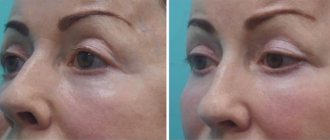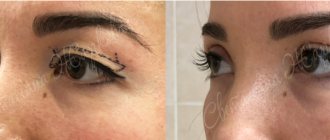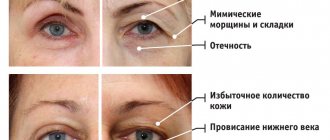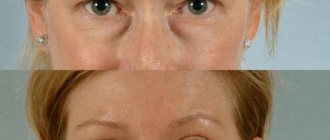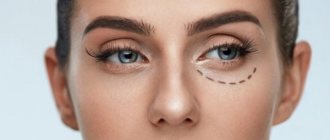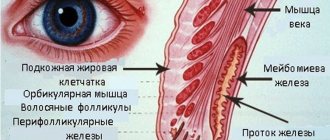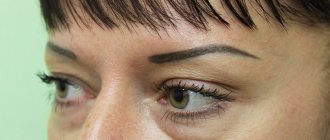Everyone wants to preserve and prolong their youth - special cosmetics, a healthy lifestyle, healthy eating and sports undoubtedly help in solving this issue. But still, age-related skin changes are inevitable. The skin around the eyes is very delicate, so even very young people face the problem of crow's feet. First we are talking about small wrinkles, then the corners of the eyes begin to droop. As a result, the general facial expression changes, the look becomes dull, the person looks older. Canthopexy - lifting the corners of the eyelids - helps to quickly cope with this phenomenon and restore the look to its former enthusiasm and charm.
General information
Blepharoplasty is a type of surgical intervention. During the operation, excess skin is excised and fat deposits are removed. As a result, the shape of the eyelids changes.
Canthopexy (canthus - “corner”) is aimed at correcting the corners of the eyes (external and internal).
Buyanov Sergey Yurievich (Expert Doctor):
With canthopexy (“pexy” - “suturing” in Latin), the surgeon does not cut the muscles of the eye, but pulls them in the desired direction and fixes them in a given position.
The combination of these procedures is the most effective method of transformation and rejuvenation of the periorbital zone - muscles and tendons are tightened and stabilized.
There is an operation with a similar name - canthoplasty. During this procedure, the tendon is separated from the bone from the side of the orbit and removed in places.
Changes after surgery
- Notice tightening of the skin under your eyes
- Get rid of dark circles and bags
- Forget about the problems of puffiness and swelling of the eyelids
- If you have myopia, then you know first-hand what “bulging eye syndrome” is. After canthopexy the problem goes away completely.
- The drooping of the outer corners of the eyes will disappear, thereby your face will look healthier and happier (in people with drooping eyelids, the face always looks tired and gloomy).
- If there is congenital asymmetry in the location of the eyes, surgery removes all defects.
- Surgical manipulation will save you in the most dire situations. Even after suffering facial paralysis, mobility is completely restored.
- Solve the problem of blepharophimosis (shortening of the palpebral fissure).
- If ptosis is present (after injuries), the problem is completely eliminated.
- You can get that fashionable “cat look.”
Indications for use
Changes in the periorbital area are primarily due to the fact that the skin around the eyes is thin and sensitive.
Its condition is negatively affected by environmental factors (UV rays and ecology), and excessive facial stress and even genetics are also of great importance. In the latter case, the main indication for surgical intervention is the client’s desire to change his appearance to meet beauty standards - this is not necessarily associated with age-related deformities.
It is believed that the outer corner of the eye should be slightly higher than the inner corner (no more than 3 mm).
It is recommended to resort to blepharoplasty with canthopexy in the case of:
- signs of ptosis;
- deformation of the outer eyelid due to weakening of tendons and muscles;
- chronic inflammation;
- inversion of the lower eyelid after unsuccessful blepharoplasty or previous paralysis;
- diseases of the conjunctiva;
- the need to tighten tendons and stabilize muscles;
- blepharophimosis;
- “bulging” eye syndrome accompanying myopia;
- fatty hernias;
- pathologies of the eyelids of a congenital nature (for example, partial fusion);
- eye asymmetry.
What is canthopexy?
Plastic surgery in the area of the outer corners of the eyes - canthal tendon. Allows you to eliminate ptosis (drooping) of the lower eyelid, lift the drooping outer corners of the eyes, change the shape and size of the palpebral fissure. Canthopexy eliminates a tired, menacing look, giving it youth and freshness. Most often, canthopexy is performed simultaneously with lower blepharoplasty.
Canthopexy at the Kivach clinic
Plastic surgeons at the clinic recommend that you undergo the “Body Cleansing” program before surgery. This normalizes the physiological balance and minimizes possible risks of complications during surgery and during the recovery period.
After surgery, patients are offered comprehensive programs to accelerate the healing of postoperative wounds and reduce swelling. These programs can reduce the rehabilitation period by an average of 2 times.
Check out our programs
OPTIMUM for face
OPTIMUM for the body
PREMIUM for face
PREMIUM for body
Indications
- Age-related changes in the eyelid area.
- Excess skin of the lower eyelid.
- Drooping of the corners of the eyes.
- Eversion of the lower eyelid.
- Bulging eye.
- Correction after lower blepharoplasty performed without manipulations reinforcing the lower eyelid.
results
- Rejuvenation of the eyelid area.
- Lifting the corners of the eyes.
- Increased elasticity of the lower eyelid.
- Normalization of the tone of the lower eyelids.
- Correction of a bulging eye.
- The consequences of lower blepharoplasty are corrected.
About the operation
Operation duration:
1-2 hours. The duration may be increased for medical reasons.
Duration of the rehabilitation period:
1-3 weeks.
Effect:
can be finally assessed 1-2 months after the edema disappears.
Canthopexy technique
In most cases, canthopexy is performed simultaneously with lower blepharoplasty. Before the operation, consultation with a surgeon and ophthalmologist is necessary. To identify possible contraindications, the patient undergoes a series of tests.
Download our guide to find out what tests you need to complete.
The operation is performed under general or local anesthesia with additional sedation (superficial sleep). A small incision is made in the natural crease of the outer eyelid. Through this incision, the surgeon reaches the canthal tendon, which holds the corners of the lower eyelid. The tendon is stretched and fixed to the periosteum of the orbit. Cosmetic stitches are applied.
If there is excess tissue in the lower eyelid, excess skin fragments in the corners of the eyes are removed. The operation is performed without removing part of the tendon, which, together with the muscles, is stretched and fixed with a special suture thread at the periosteum.
During the consultation, the clinic’s plastic surgeon will listen to your wishes, conduct an examination,, if necessary, prescribe additional studies and suggest correction methods that best suit you.
To get a consultation
Contraindications
- Blood clotting disorders.
- Diabetes mellitus in the stage of sub- and decompensation.
- Tendency to form keloid scars.
- Chronic diseases in the acute stage.
- Infectious diseases.
- Glaucoma.
- Severe myopia.
Question answer
- When can the result be assessed?
- The result can be assessed 1-2 months after the complete disappearance of swelling and hematomas (bruises).
- What result should you expect?
- Canthopexy helps eliminate the so-called scleral show. Normally, the lower eyelid should cover the eyeball to the lower edge of the iris. With the scleral appearance, the edge of the lower eyelid is lower, creating a “tired” appearance.
Overall, the results look like this:
- rejuvenation of the skin around the eyes;
lifting the corners of the eyes;
- increasing the elasticity and tone of the lower eyelids;
- correction of a bulging eye;
- change in eye shape.
- Is the operation safe?
- The operation is virtually safe. Does not affect the optic nerve and does not impair the quality of vision. A medical examination before the operation guarantees the absence of contraindications to its implementation.
- How to prepare for surgery?
- Before the operation, you will need to undergo a full medical examination, including consultations with a plastic surgeon and an ophthalmologist.
Important doctor's advice:
- 7 days before surgery, it is advisable to quit smoking.
On the day of surgery, do not use decorative or skincare cosmetics.
- How long is the rehabilitation period?
- Healing of postoperative incisions occurs quickly. All scars remain invisible in the natural folds of the skin. The recovery period, which requires the patient to comply with certain restrictions, lasts no more than 1 month.
Important doctor's advice:
- For 10-14 days after surgery, limit excessive physical activity, avoid eye strain, avoid using skincare and decorative cosmetics, and wearing contact lenses.
For 30 days after surgery, do not visit the bathhouse, sauna, solarium, and avoid exposure to UV rays.
- Are there any complications?
- Serious complications are completely excluded. Edema, swelling, hematomas, and irritation of the mucous membranes of the eyes are allowed. These natural postoperative phenomena go away on their own after 10-15 days.
Completing the “Body Cleansing” program before surgery minimizes the risk of complications.
- What guarantees the success of the operation?
- Certified plastic surgeons.
- Compliance with medical standards.
- Completing the “Body Cleansing” program before surgery minimizes the risk of complications.
- Completing any of the comprehensive programs after surgery will shorten the rehabilitation period.
The rejuvenating effect lasts for 5-10 years. If canthopexy is combined with eye reshaping surgery, the results are permanent.
Carrying out restoration procedures according to one of the comprehensive programs will speed up the tissue healing process and reduce the rehabilitation period by approximately 2 times.
The cost of the operation does not include the cost of anesthesia
Canthopexy (lifting the outer corners of the eyes)
| Name of procedure | Cost of one procedure (RUB) |
| Canthopexy - 1st eyelid | 15 800 |
| Canthopexy – 2 centuries | 29 400 |
| Correction of eye shape and shape (canthoplasty) | |
Contraindications
Before carrying out the operation, it is necessary to adequately weigh all the pros and cons.
In order to avoid getting an undesirable result, it is worth identifying at the preparatory stage all possible contraindications that can aggravate the process itself and the subsequent rehabilitation period. Among them:
- oncology;
- pregnancy;
- lactation;
- period;
- chronic pathologies in an acute form;
- unsatisfactory blood clotting indicators;
- diabetes;
- disruption of the endocrine and cardiovascular systems;
- severe myopia;
- epilepsy;
- autoimmune pathologies;
- psychosomatic disorders;
- inflammatory processes in the body;
- glaucoma;
- dry eye syndrome;
- viral and infectious diseases.
Buyanov Sergey Yurievich (Expert Doctor):
Blepharoplasty with canthopexy and even canthoplasty does not solve the problem at all with swelling of the eyelids associated with kidney pathology, exophthalmos with damage to the thyroid gland (goiter, myxedema), as well as with the formation of dark spots under the eyes associated with impaired pigment metabolism. Surgery does not eliminate the causes, so the results of the operation will soon disappear.
Kinds
Blepharoplasty can be upper, lower or circular (the latter is aimed at both eyelids).
Canthopexy happens:
- Lateral - designed to correct the outer corner of the eye, deformed due to age or other factors. Additionally, they eliminate skin wrinkles, excess dermis and reduce the severity of the network of wrinkles.
- Medial - during the operation, the inner corner of the eye is affected, and the shape changes. This method is characterized by low traumatic rates.
When carrying out these procedures, a double effect is simultaneously ensured (For example, removing drooping eyelids and bags under the eyes).
Lower blepharoplasty with canthopexy reviews
Alina, 41 years old
Few people understand us, people with bags under our eyes. Basically, they advise drinking less liquid at night and applying compresses. But I have had this problem for a long time, since my youth, and nothing helps. If earlier the option had been to get rid of them, I would have already done it. I had blepharoplasty done in one of the clinics my friend tested. I was offered to have the operation together with canthoplasty, because with age the muscles on the face become weaker and there is a possibility that after blepharoplasty the eyelid will not fit tightly to the eye. I agreed and did not regret it. The result was not immediate, but excellent. The only thing I regretted was that I did it under local anesthesia; I experienced real stress.
Preparation
At the initial consultation with the surgeon, wishes regarding the result of the procedure are discussed, after which a 3D model is drawn up.
Moreover, it is necessary to undergo a series of tests to get a complete picture of the patient’s health and identify possible contraindications. These include urine tests, as well as general and chemical blood tests. Additionally, fluorography and a cardiogram should be done.
Before the operation, you need to follow a number of rules and adhere to some recommendations.
- Do not drink alcohol for 2 weeks before the procedure. Otherwise, the risk of swelling increases.
- Do not smoke - nicotine thins the blood and disrupts its microcirculation.
- You should stick to your diet. Salty foods, coffee, chocolate, confectionery and citrus fruits are excluded from the diet.
- You will also have to give up some medications: aspirin, paracetamol, diclofenac and ibuprofen due to their property of thinning the blood.
- It is necessary to reduce the level of physical stress on the body and try to first resolve all issues regarding work and everyday problems in order to be able to rest peacefully during the recovery period.
How is the operation carried out?
The surgical procedure takes place on an outpatient basis under anesthesia.
Anesthesia can be either local or general, depending on the scale of exposure and individual characteristics.
The average session duration is no more than 2 hours.
In the process, the surgeon excises the skin using a scalpel in the area of the natural fold of the dermis. As a result, an incision is formed through which the epicanthus is tightened. If necessary, part of the tendons is removed.
Stages
- Marking the boundaries of the impact with a special marker.
- Disinfection with an antiseptic.
- Immersion of the patient in a state of anesthesia.
- Excision of skin. The length of the incision does not exceed 1 centimeter. At this stage, tension occurs in the tendons and muscles.
- At the end, subcutaneous sutures made of self-absorbable material are applied.
Blepharoplasty
Local and general anesthesia can be used for pain relief. During the operation, the doctor makes an incision along the upper eyelid, at a perfectly measured angle, to avoid the formation of scars after the operation. During the procedure, excess skin and fatty tissue are excised.
The procedure can last from half an hour to two hours, it depends on the complexity of blepharoplasty and the individual characteristics of the patient. After all the manipulations, stitches are applied and sealed with a special plaster. If everything is fine with the patient, after examination by the surgeon, after an hour he can go home, accompanied by someone close to him.
Rehabilitation period
Complete restoration of the skin occurs within 2-3 weeks. During this time, a thin pink line forms at the site of the incision.
The appearance of slight swelling and hematomas is acceptable, which usually disappear within 7 days.
The patient may also experience other discomforts:
- tearfulness;
- burning;
- photosensitivity;
- hypersensitivity.
You can alleviate the condition by applying cool compresses based on herbal infusions.
It is important to follow the doctor's recommendations:
- At first, it is forbidden to use lenses and influence the eyelids and mucous membrane in any other way, such as simply touching this area with your hands.
- The strain on the eyes and the body as a whole should be reduced. The ban includes going to the gym, reading literature and watching TV.
- You cannot visit the sauna, solarium or sunbathe in natural conditions.
- It is also recommended to control head movements and avoid sudden bends. It is better to sleep on a high pillow to normalize the outflow of lymph in the required quantities.
To speed up the healing period, the doctor may prescribe special ointments that help eliminate swelling and bruising, as well as reduce pain. Additionally, he prescribes eye drops that help prevent the appearance of “dry” eyes.
Recovery after surgery
The rehabilitation period takes approximately a month. After this time, the body is completely restored and you can return to your normal lifestyle. The patient stays in the hospital for about 2 days, then care is provided independently at home. Surgical threads dissolve in 7-10 days. Painkillers are prescribed for the entire period. Approximate regimen: 2 tablets per day. Every 12 hours.
- It is forbidden to wear lenses during the recovery period
- It is recommended to sleep only on your back
- Limit physical activity
- Do not visit saunas, baths
- Hold off on using decorative cosmetics
- Limit reading
- Do not be in direct sunlight, do not look at bright objects
- Minimize computer work
The effect after the operation lasts for ten years, repeated operation is possible.
Possible complications
In case of deviation from the recommended norms during the preparatory stage and rehabilitation, a number of complications may arise that require certain additional therapy.
Also, the reason often lies in an incomplete medical history of the patient or in connection with a surgical error.
Possible side effects:
- compaction in the suture area, after which a rough scar forms (may be due to individual characteristics, poor quality of suture material or incorrect actions of the surgeon);
- damage to the lacrimal canal or its displacement, resulting in drying out of the mucous membrane;
- infection;
- neoplasm in the form of a cyst;
- heavy bleeding;
- seam divergence;
- hematomas;
- severe swelling;
- problems with closing the eyelid in case of excision of the skin beyond the norm;
- eversion of the eyelid due to excessive tension of the tendons;
- pigmentation that appears after severe bleeding and the formation of dark-colored blood breakdown products under thin layers of the dermis;
- asymmetry;
- diplopia.
Epicanthus
The epicanthus or Mongolian fold is a semilunar fold of skin on the medial canthus. This condition does not cause any symptoms and is a cosmetic defect.
It is observed in representatives of the Australo-Negroid and Mongoloid races. For Europeans - atypical.
Possible darkening of the visual axis, associated ptosis, strabismus.
Scientists believe that in people of the Mongoloid race it appears as a protective apparatus for the organs of vision from specific climatic conditions. The development of epicanthus leads to:
- ptosis;
- avulsion of the medial canthus after injury;
- Down syndrome.
Photos before and after
Service cost
Blepharoplasty with canthopexy is not a cheap pleasure. Average cost of the procedure: 30-40 thousand rubles.
The following factors influence the final amount:
- development of the city's infrastructure;
- level of competition;
- the specifics of the clinic (multidisciplinary ones in most cases have a more loyal pricing policy);
- personnel qualifications;
- selected anesthesia and disinfectant;
- scale of the operation.
Opinion of cosmetologists
The majority of specialists express only a positive opinion regarding blepharoplasty with canthopexy. They note that this is a fairly simple method of intervention, as a result of which the appearance is noticeably transformed.
A plastic surgeon consults a potential client and talks about an individual approach in any case:
The specialist talks about the possible need to replace canthoplasty with other procedures:

